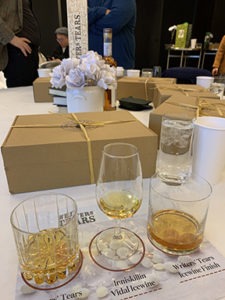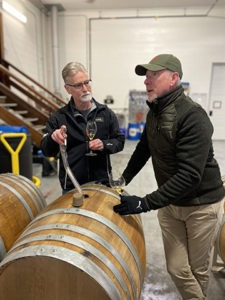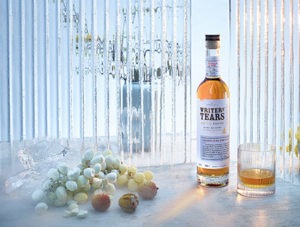Looking very much the proper Irishman, sporting a grey tweed jacket and bowtie, Bernard Walsh appeared inordinately comfortable on the deck of the Park Hyatt’s 17th-floor Terrace Room, despite the rather bracing late autumn afternoon.

Walsh Whiskey co-founder Bernard Walsh.
Having just emerged from the chit chat and glad-handing following the launch of his Writers’ Tears Icewine Cask Finish whiskey, it could simply have been the residual warmth of the celebration with media and trade.
Or maybe it was the 46% ABV of the whiskey in hand.
Either way, if Walsh was experiencing a warm and fuzzy feeling, he had every right.
(As an aside, I think I deserved some sort of acknowledgement myself, having blitzed through the Drink Chile Wine Expo earlier in the day, where I sampled and scribbled notes on 34 wines over a three-hour span, before making the 30-minute walk from Arcadian Loft to the Park Hyatt Toronto just in time for the Writers’ Tears event.)
To be honest, some of the giddiness in the room last Wednesday probably owed to the fact that this was the first wine and spirits trade event for most in attendance since Covid and its accompanying lockdown came along and ruined the next 600 days.
But it was also a legitimately great opportunity to meet the man who, along with wife Rosemary, was responsible for the famed Writers’ Tears and The Irishman, and to taste their newest effort, the first Irish whiskey to be finished in icewine casks.
 It was an impeccably organized event, as usual, from the Etobicoke, Ontario-based Woodman Wines & Spirits agency, which represents Walsh Whiskey in Canada. And this is very much a Woodman story too, with company V.P. Jason Woodman first crossing paths, and glasses, with Bernard at the 2009 Vinexpo international wine and spirits trade exhibition in Paris.
It was an impeccably organized event, as usual, from the Etobicoke, Ontario-based Woodman Wines & Spirits agency, which represents Walsh Whiskey in Canada. And this is very much a Woodman story too, with company V.P. Jason Woodman first crossing paths, and glasses, with Bernard at the 2009 Vinexpo international wine and spirits trade exhibition in Paris.
Two years later, Walsh’s ‘water of life’ was in the LCBO. “I remember that first listing, 120 cases of six bottles,” Walsh says. “We just wanted the chance to tell the story.”
LEAP OF FAITH
It was actually a big step even for the LCBO. There was little demand for premium Irish whiskeys at the time. Retail outlets and restaurants would say, ‘We’ve already got one; why do we need another?’ Walsh remembers.
There was risk, too, in Bernard and Rosemary even exploring whiskey-making when they opened up their mom-and-pop operation back in 1999. “Irish whiskey was falling off a cliff. There were only three distilleries left. A handful of whiskey companies, a few blenders, no cooperage (barrel makers). Just 2 million cases globally,” Bernard shares. “Thankfully, over the last 22 years, Irish whiskey has bounded back. It’s now over 12 million cases, and last I checked there were 38 whiskey distilleries in operation on the island—many of them smaller boutiques. You need the smaller guys to push an agenda to diversify.
“In the 18th century, Irish whiskey was big business,” Walsh notes. “Everywhere the British Empire went, truckloads of Irish whiskey followed. The thing that made it famous was the quality, which you can trace back to the distillation process—typically in a copper pot still.”
The key for Walsh has been recreating that same formula for success—combining their single pot still and single malt whiskeys together, then triple-distilling from 100% barley (malted and unmalted). The single pot still portion provides the spice and warmth up front, Walsh explains. “Then the malt kicks in and you get a lovely fruity palate—green apple, pear.”
It’s a sinfully smooth combo. While their friends in the Irish whiskey community initially called it sacrilege—and it’s also a decidedly more expensive process—the combo “was known as the Champagne blend in the 1800s,” Walsh says. “So we thought, ‘Let’s get back to what we used to enjoy.’”
That includes the wood employed to age it. “I love bourbon and bourbon barrels (the use of which is common now). But before 1860, it was French wine barrels, cognac casks, port pipes (350+ litre casks) and sherry butts (standard sherry casks).” (The name Writers’ Tears, incidentally, is an ode to those golden years of Irish whiskey, which perhaps not coincidentally coincided with a golden era of Irish novelists, poets and playwrights, such as George Bernard Shaw, Oscar Wilde, W.B. Yeats, Lady Gregory, James Joyce, Samuel Beckett and Bram Stoker.)
Walsh has continued to push the boundaries ever since, with offerings finished in Marsala and cognac casks, among others. “It layers on flavours, but I still want you know this is Irish whiskey,” he stresses.
A MATCH MADE IN HEAVEN
But percolating between his ears since his first visit to Ontario has been another unique marriage.

Walsh with then-head winemaker at Inniskillin (now retired) Bruce Nicholson.
“I’ve been coming to Canada since 2011. I love this country,” Walsh says. “On that first trip, Russell (Woodman Wines & Spirits president Russell Woodman) brought me to a few nightclubs. But the one thing he really wanted me to taste was the icewine. This is not a fortified wine, this is a natural sweet wine, a national treasure for Canada. The quality was superb. We can’t do it in Ireland with our climate.”
“When Bernard approached me with the idea of an icewine-finished whiskey, it was a real pleasure for me to make an introduction to the great Inniskillin Winery and (owner) Arterra (Wines Canada),” shares Jason Woodman. “To see the results is very satisfying.”
The timing of the introduction proved to be a stroke of luck—just before the Covid lockdown began in Ontario.
Bernard and Rosemary visited the Niagara Peninsula in January 2020, meeting Inniskillin’s then-head winemaker Bruce Nicholson (now retired), touring the vineyard and sampling wines before selecting 12 hogshead casks originally manufactured by the renowned Berthomieu Cooperage in France. The barrels were disgorged of icewine in March 2020 and shipped to Ireland, where, two months later, they were filled with Writers’ Tears Copper Pot whiskey.
Walsh and company religiously checked the barrels at monthly intervals. “At 12 months, it was perfect,” Bernard says. And so in May of this year, the contents were bottled (at 46% ABV).
BALANCING ACT
The result is a limited-edition release of 3,500 super-premium bottles destined for Canada, the U.S., Ireland (at $99.95 Cdn. apiece.)

Writers’ Tears Icewine Finish whiskey. Photo by Trevor Hart.
The core expression of Writers’ Tears gets a whole new dynamic when complemented by the intense natural sweetness imparted by Inniskillin’s famed Vidal Icewine, the 1989 vintage of which won the Grand Prix d’Honneur at Vinexpo, putting Canada on the global wine map.
“The whiskey’s nose delivers a honey-peach and apricot over a unique pot-still spice. In the mouth it offers floral and nutty oak, with a fruity, lychee-like finish,” Walsh describes.
It’s also clear from the extra heat that we’ve moved from the 40% ABV of the original Writers’ Tears to 46% ABV with the Icewine Finish. But there is also an added depth and mouthfeel to the mix, striking a delicate balance without tipping into the sweet and sappy range.
As Ziraldo himself noted, the key to great icewine is striking that ideal harmony of the natural residual sugars in the glass (roughly 225-250 grams per litre for Inniskillin’s Vidal Icewine) with the inherent acidity of the grape.
Walsh seems to have pinpointed that equilibrium with this new expression of his celebrated whiskey. It’s indeed something special.
But Wednesday’s launch also served as a reminder of just how friggin’ outstanding the original Writers’ Tears is.
So cheers to both!
Or, in the native tongue, Sláinte!
(Check out a video of the event below)




Leave a Reply
Your email is safe with us.